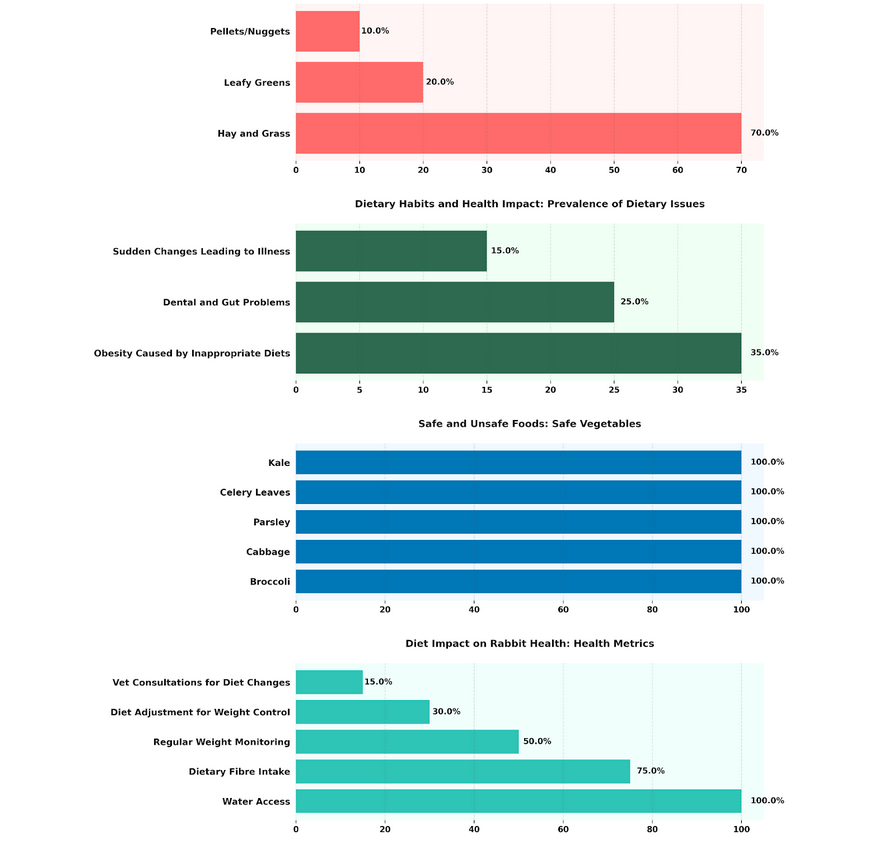The Rabbit Diet Safety Statistics provides a comprehensive overview of the dietary habits, health impacts, safe and unsafe foods, and diet-related health metrics for rabbits. This data is essential for understanding the critical components of a rabbit’s diet, potential health issues arising from inappropriate diets, and measures to ensure optimal health in rabbits.
Dietary Habits and Health Impact Essential Components of Rabbit Diet
Dietary Habits and Health Impact reveals the fundamental components of a rabbit’s diet and highlights prevalent dietary issues.
- Essential Components of Rabbit Diet: The ideal rabbit diet primarily consists of 70% hay and grass. This high percentage underscores the importance of fibrous food, essential for maintaining healthy digestion and preventing dental problems. Hay and grass replicate a rabbit’s natural diet, ensuring proper gut function and dental wear.
Leafy greens make up 20% of the diet, providing essential vitamins and minerals. These should be varied and introduced gradually to prevent digestive upset.
Pellets or nuggets account for 10% of the diet, offering a concentrated source of nutrients. However, over-reliance on pellets can lead to obesity, so they should be given in moderation. - Prevalence of Dietary Issues: Problems like obesity caused by inappropriate diets affect 35% of rabbits. This often results from excessive pellet feeding, lack of exercise, and high-calorie treats. Dental and gut problems affect 25%, usually due to inadequate hay consumption, leading to overgrown teeth and gastrointestinal issues. Sudden changes leading to illness impact 15%, highlighting the importance of gradual dietary transitions to prevent stress and digestive disturbances.
Safe and Unsafe Foods emphasizes the importance of offering safe vegetables to rabbits.
- Safe Vegetables: Foods like broccoli, cabbage, parsley, celery leaves, and kale are deemed 100% safe for consumption. These vegetables provide necessary nutrients without causing harm, as long as they are introduced slowly and fed in moderation.
Including a variety of these vegetables ensures a balanced intake of vitamins, minerals, and antioxidants, promoting overall health and well-being.
Diet Impact on Rabbit Health focuses on key health metrics that affect a rabbit’s overall well-being.
- Health Metrics: Ensuring 100% access to water is crucial for hydration and digestion. Dehydration can lead to severe health issues, so fresh water should always be available.
Dietary fiber intake is at 75%, underscoring the importance of hay for healthy gut movement and preventing blockages.
Regular weight monitoring is practiced by 50% of owners, vital for detecting obesity or unhealthy weight loss early.
Diet adjustment for weight control is implemented by 30%, indicating a proactive approach to maintaining ideal body weight.
Vet consultations for diet changes are sought by only 15%, suggesting that many rabbit owners may not fully utilize professional advice when adjusting diets.
The 70% reliance on hay and grass in a rabbit’s diet emphasizes its significance in maintaining digestive health and preventing dental issues. The high fiber content in hay is essential for the continuous wear of a rabbit’s teeth, which grow throughout their life. Without sufficient fiber, rabbits can develop dental disease, leading to serious health complications.
The 35% prevalence of obesity due to improper diets is a significant concern. Obesity in rabbits can lead to various health problems, including heart disease, arthritis, and reduced lifespan. Owners should focus on providing a balanced diet with limited high-calorie foods and encourage regular exercise to maintain a healthy weight.
Safe vegetables like broccoli, cabbage, and kale provide diversity in a rabbit’s diet. These vegetables should be washed thoroughly to remove pesticides and introduced gradually to avoid digestive disturbances. They can be part of a rotation, ensuring rabbits receive a variety of nutrients.
The need for 100% water access cannot be overstated, as dehydration can quickly lead to life-threatening conditions. Owners should check water bottles or bowls daily to ensure they are clean and functioning properly. The emphasis on dietary fiber intake (75%) aligns with the need for a hay-centric diet, supporting both gut health and effective digestion.
Regular weight monitoring is crucial but only practiced by 50% of owners, highlighting an area for improvement in rabbit care. Monitoring a rabbit’s weight regularly allows for timely interventions if any health issues arise. Adjusting the diet to control weight, practiced by 30%, is a proactive measure that can prevent obesity and its associated health risks.
Finally, the low percentage of vet consultations (15%) for diet changes suggests many owners may not be fully informed about the best dietary practices. Consulting with a veterinarian can provide personalized guidance and ensure that any dietary adjustments align with the rabbit’s specific health needs.
Cryptocurrency Industry Statistics
Carpet Cleaning Industry Statistics
In summary, the Rabbit Diet Safety Statistics highlights the critical aspects of maintaining a balanced and safe diet for rabbits. By prioritizing hay and grass, incorporating safe vegetables, monitoring weight, and seeking professional advice, rabbit owners can significantly enhance their pet’s health and quality of life. Understanding these dietary statistics is essential for preventing common health issues and ensuring that rabbits thrive in their environment.

